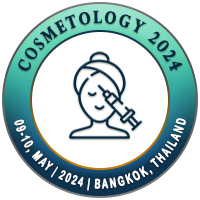
Amal Chamli
Habib Thameur Hospital, TunisiaTitle: Efficacy of photodynamic therapy in the treatment of actinic cheilitis
Abstract
Background: Photodynamic therapy (PDT) is a modern and non-invasive treatment modality for actinic cheilitis (AC). The scarcity of high-quality studies remains the primary limitation in determining the effectiveness and tolerability of the technique. The main aim of our study was to assess the efficacity and adverse effects of PDT in the management of AC.
Methods: We conducted a prospective and descriptive study in the Department of Dermatology of the university hospital of Habib Thameur of Tunis. Patients with AC received two sessions of methyl-amino levulinate (MAL)-PDT at one-month intervals. Red light (633nm, 37j/cm2, 10 minutes) was used. Patients were assessed at 1 week, 1 month, and 3 months for clinical outcomes and adverse effects. The recurrence rate was evaluated at 6 months.
Results: Four patients (2 males and 2 females) were included with a mean age of 46.5± 17.9 years. AC was staged as grade 1 (n=1), grade 3(n=1) and grade 4(n=2). Complete clinical remission was achieved in two patients. Two others showed partial remission with improvement superior to 50 % of their AC. The technique was painful in all patients with a mean Visual Analogue Scale score of 8. Self-limiting local phototoxicity was seen in two cases after one week of PDT. Transient hyperpigmentation was observed in two patients. None of the patients relapsed at 6 months of follow-up.
Conclusion: MAL-PDT is an effective treatment option in AC. Pain is the main limiting factor. Prescription of daylight-PDT could reduce the risk of side effects. Other prospective and comparative trials are need in the future to determine its superiority comparing to the other treatment modalities.
Biography
TBA

